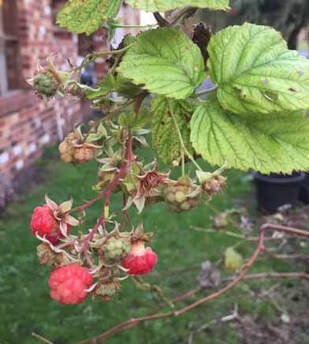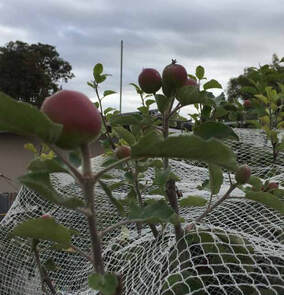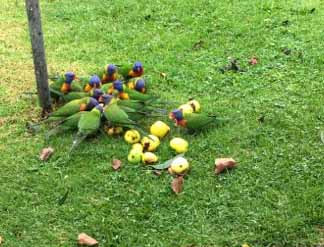 Midwinter raspberries: a sign of the times?
Midwinter raspberries: a sign of the times? By John Coldebella
EVERY year is different in the garden. Outcomes and productivity vary with all the possible combinations of weather conditions which include cold, warm, hot, dry and wet. Whichever conditions arise, some plants will thrive and others won't. The same goes for the many pests that attack plants, fruit and vegetables. There's always something new to observe and this past growing season was no exception. Throw in some climate change and anything can happen.
Last year's wet spring was ideal for earwigs and slater bugs, also known as woodlouse or Malacostraca Isopoda. Between them, they wiped out my first planting of beans as they came out of the ground.
EVERY year is different in the garden. Outcomes and productivity vary with all the possible combinations of weather conditions which include cold, warm, hot, dry and wet. Whichever conditions arise, some plants will thrive and others won't. The same goes for the many pests that attack plants, fruit and vegetables. There's always something new to observe and this past growing season was no exception. Throw in some climate change and anything can happen.
Last year's wet spring was ideal for earwigs and slater bugs, also known as woodlouse or Malacostraca Isopoda. Between them, they wiped out my first planting of beans as they came out of the ground.
After the second crop emerged, I went out with a torch every night for over a week, crushing these pests by hand till the plants were big enough to survive a nightly chewing. Having reached this stage, the regular rain and mild summer made for a very successful crop. The lack of scorching days meant less days of stress on the plants.
Pumpkins also thrived on the 20-30 mm of rain that came every few weeks along with the absence of extreme heat which can burn the tips of the plants which spread across the landscape.
Stone fruit were not so happy. Apart from the pre-Christmas apricots and peaches, the moist conditions led to much of the fruit developing mould. But not all was lost. Stone fruit much prefer a hot dry summer, but not so hot as to burn them. Black Saturday was the first time I saw fruit cooked on the tree. On that day, apples and walnuts exposed to the northwest afternoon sun were baked. This has occurred several times since then but with temperatures much lower, around 37 degrees. The same temperature in January can melt the blossom of the Chilean guava, ending the crop before it begins. It would seem that the intensity of the sun is increasing.
Autumn saw warm to hot days well into April with a 30 degree day early in that month. These temperatures made for another bumper crop of beans that had been planted on a gamble at the end of December.
Pumpkins also thrived on the 20-30 mm of rain that came every few weeks along with the absence of extreme heat which can burn the tips of the plants which spread across the landscape.
Stone fruit were not so happy. Apart from the pre-Christmas apricots and peaches, the moist conditions led to much of the fruit developing mould. But not all was lost. Stone fruit much prefer a hot dry summer, but not so hot as to burn them. Black Saturday was the first time I saw fruit cooked on the tree. On that day, apples and walnuts exposed to the northwest afternoon sun were baked. This has occurred several times since then but with temperatures much lower, around 37 degrees. The same temperature in January can melt the blossom of the Chilean guava, ending the crop before it begins. It would seem that the intensity of the sun is increasing.
Autumn saw warm to hot days well into April with a 30 degree day early in that month. These temperatures made for another bumper crop of beans that had been planted on a gamble at the end of December.
| It is not unusual to see plants fooled by these warm days into producing the odd blossom, and grapevines and walnuts can sprout new shoots even as the leaves are falling, but the rude shock of winter eventually puts an end to any further progress. This autumn was so warm that the branches of the apple tree that grew through the net not only produced blossom, but went on to attempt a second crop which attained the size of a walnut. This was much appreciated by the lorikeets and eastern rosellas which by the month of June had been reduced to grazing on radicchio seeds, some small, grub-filled Granny Smith apples which I retrieved from under the net and threw on the lawn, and the last of the yellow guavas. It occurred to me that with diminishing habitats, these native birds are becoming dependent on humans for their survival. Their arrival in Bass Coast, along with galahs and corellas coincided with the millennium drought, and their numbers seem to increase each year. They are now a fact of gardening life along with nets on fruit trees. |
Despite the bitter cold and frosty mornings, there are signs of an early spring from some plants while others are maintaining their usual dormancy. Some plants respond to heat while others make their moves based on the number of daylight hours.
This year's first almond blossom came three weeks earlier than last year and the macadamia flowers have begun two months earlier than usual. One variety of blueberry is covered in blossom while another waits leafless for more encouraging signs. While it is not uncommon to see the odd raspberry or strawberry ripening at this time of year, it’s less common to see a blackbird with white markings on the back of its neck and a white fleck on its left wing. As I said previously, in the garden anything can happen.
This year's first almond blossom came three weeks earlier than last year and the macadamia flowers have begun two months earlier than usual. One variety of blueberry is covered in blossom while another waits leafless for more encouraging signs. While it is not uncommon to see the odd raspberry or strawberry ripening at this time of year, it’s less common to see a blackbird with white markings on the back of its neck and a white fleck on its left wing. As I said previously, in the garden anything can happen.

